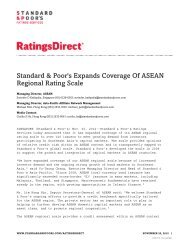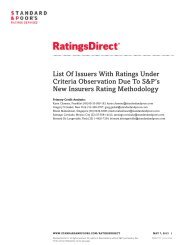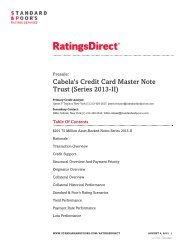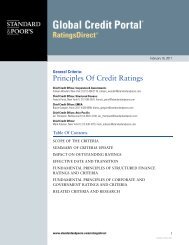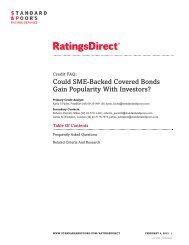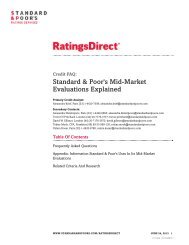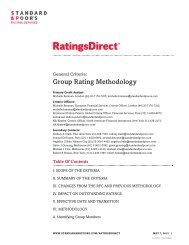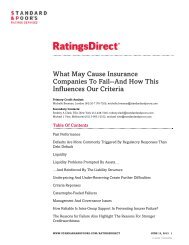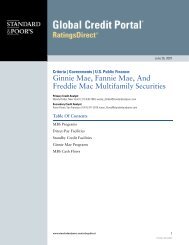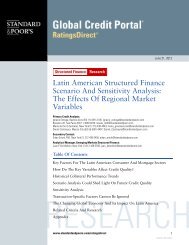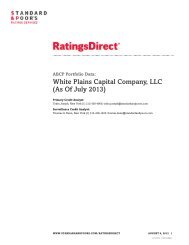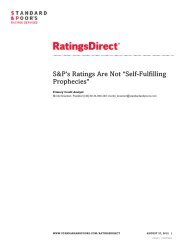Schaeffler AG's Recovery Rating Profile - Standard & Poor's
Schaeffler AG's Recovery Rating Profile - Standard & Poor's
Schaeffler AG's Recovery Rating Profile - Standard & Poor's
Create successful ePaper yourself
Turn your PDF publications into a flip-book with our unique Google optimized e-Paper software.
<strong>Recovery</strong> Report:<br />
<strong>Schaeffler</strong> <strong>AG's</strong> <strong>Recovery</strong> <strong>Rating</strong><br />
<strong>Profile</strong><br />
Primary Credit Analyst:<br />
Antoine Cornu, Paris (33) 1-4420-6796; antoine_cornu@standardandpoors.com<br />
<strong>Recovery</strong> Analyst:<br />
Prajakta Sabnis, London (44) 20-7176-7086; prajakta_sabnis@standardandpoors.com<br />
Table Of Contents<br />
Overview<br />
Legal And Structural Considerations<br />
Issuer Credit <strong>Rating</strong> Rationale<br />
<strong>Recovery</strong> Analysis<br />
April 17, 2012<br />
www.standardandpoors.com/ratingsdirect 1<br />
958466 | 300374394
<strong>Recovery</strong> Report:<br />
<strong>Schaeffler</strong> <strong>AG's</strong> <strong>Recovery</strong> <strong>Rating</strong> <strong>Profile</strong><br />
Overview<br />
• We are providing our recovery analysis on German automotive component and systems and industrial bearings<br />
manufacturer <strong>Schaeffler</strong> AG, the borrower of the senior credit facilities, and <strong>Schaeffler</strong> Finance B.V., the finance<br />
vehicle and issuer of the senior secured notes.<br />
• We used a going-concern approach in our valuation of <strong>Schaeffler</strong> AG, owing to our view of its strong brand name<br />
and leading positions in certain automotive-component and industrial bearings segments.<br />
• Our simulated default scenario assumes a payment default in 2015, due to significant deterioration in operating<br />
performance and reduced free cash flow generation triggered by the group's inability to refinance its syndicated<br />
facility B maturing in January 2015.<br />
• Under our assumptions, we arrive at a stressed enterprise value of about €7 billion, resulting in a recovery rating<br />
of '3' corresponding to meaningful (50%-70%) recovery prospects for the €2 billion equivalent senior secured<br />
notes and €1.4 billion equivalent facility C2.<br />
Table 1<br />
<strong>Schaeffler</strong> AG Credit <strong>Profile</strong><br />
Corporate credit rating B/Positive/--<br />
Estimated gross enterprise value<br />
at default (Mil. €)<br />
6,935<br />
Year of default 2015<br />
Facility/issue<br />
Restricted group<br />
<strong>Schaeffler</strong> AG<br />
Senior secured<br />
Outstanding principal at<br />
default (Mil. €) Issue rating <strong>Recovery</strong> rating<br />
Expected recovery<br />
(%) Maturity<br />
Facility B 3,000 NR NR N/A 2015<br />
Facility C1 600 NR NR N/A 2017<br />
Facility C2 (euro and dollar<br />
tranches)<br />
1,400 B 3 50-70 2017<br />
RCF 1,000 NR NR N/A 2015-2017<br />
<strong>Schaeffler</strong> Finance B.V<br />
7.75% Senior secured euro notes 800 B 3 50-70 2017<br />
7.75% senior secured dollar notes 600 B 3 50-70 2017<br />
8.75% Senior secured euro notes 400 B 3 50-70 2019<br />
8.50% Senior secured dollar notes 500 B 3 50-70 2019<br />
Unrestricted Group<br />
<strong>Schaeffler</strong> Verwaltungs GmbH<br />
Junior term loan facility* c.3700† NR NR N/A 2017<br />
Junior zero coupon bond§ c.2600† NR NR N/A 2018<br />
<strong>Standard</strong> & Poors | <strong>Rating</strong>sDirect on the Global Credit Portal | April 17, 2012 2<br />
958466 | 300374394
Table 1<br />
<strong>Schaeffler</strong> AG Credit <strong>Profile</strong> (cont.)<br />
<strong>Schaeffler</strong> Holding GmbH&Co. KG<br />
Junior RCF 250 NR NR N/A 2017<br />
<strong>Rating</strong>s as of March 30, 2012. RCF--Revolving credit facility. NR--Not rated. N/A--Not applicable. *Junior term loan facility has a cash interest element and a PIK interest<br />
element, which accrues at 6% per year. §Junior Zero coupon bond has PIK interest, which accrues at 9.625% per year. †The amount under these instruments is higher<br />
than the current outstanding amount of €5,134 million, as the debt assumed is the debt in the year of default.<br />
Legal And Structural Considerations<br />
<strong>Schaeffler</strong> is organized into two decks, an upper deck and a lower deck. The lower deck is the restricted group and<br />
comprises the parent company <strong>Schaeffler</strong> AG and its subsidiaries (<strong>Schaeffler</strong> group). The main debt at the lower<br />
deck comprises:<br />
• The above mentioned €2 billion equivalent senior secured notes, issued by <strong>Schaeffler</strong> Finance B.V. due between<br />
2017 and 2019; and<br />
• The €6 billion senior credit facilities, borrowed by <strong>Schaeffler</strong> AG (the latter is made of the initially €8.0 billion<br />
new senior credit facility minus the €2 billion Term Loan A, not utilized and cancelled as a result of the<br />
simultaneous raising of the proceeds of the €2 billion equivalent notes).<br />
<strong>Schaeffler</strong> Finance B.V. is a 100%-owned special purpose vehicle established for the only purpose of issuing the<br />
notes. The upper deck comprises all the companies above <strong>Schaeffler</strong> AG (<strong>Schaeffler</strong> Verwaltungs GmbH, <strong>Schaeffler</strong><br />
Holding GmbH & Co. KG, and INA Holding <strong>Schaeffler</strong> GmbH & Co. KG [IHO]; all not rated). The main debt<br />
located in the upper deck, together called the junior facilities, comprises:<br />
• An approximately €3 billion (current value) term loan at <strong>Schaeffler</strong> Verwaltungs GmbH (<strong>Schaeffler</strong>'s parent),<br />
maturing in June 2017;<br />
• An approximately €1.8 billion (current value) zero coupon bond due on April 1, 2018, at <strong>Schaeffler</strong> Verwaltungs<br />
GmbH; and<br />
• A €250 million revolving credit facility (RCF) at <strong>Schaeffler</strong> Holding GmbH & Co. KG (the parent of <strong>Schaeffler</strong><br />
Verwaltungs), maturing in June 2017.<br />
<strong>Schaeffler</strong> owns in total 49.9% of the shares of Continental AG with 36.1% shares held indirectly by <strong>Schaeffler</strong> AG<br />
and 13.8% held indirectly by <strong>Schaeffler</strong> Verwaltungs GmbH. The <strong>Schaeffler</strong> Group is restricted to holding no more<br />
than 49.9% of the shares in Continental AG by an investment agreement with Continental. The ownership of shares<br />
in excess of 49.9% tendered under the public tender offer in 2008 have been transferred to independent banks<br />
(described as the independent third parties in the graph below), which in aggregate own 10.4% of Continental<br />
shares.<br />
<strong>Recovery</strong> Report: <strong>Schaeffler</strong> <strong>AG's</strong> <strong>Recovery</strong> <strong>Rating</strong> <strong>Profile</strong><br />
An intercreditor agreement between the senior secured noteholders and the lenders of the senior credit facilities<br />
establishes that the notes and the credit facilities rank pari passu in both right and order of payment in a<br />
hypothetical scenario of enforcement. However, the credit facilities lenders benefit from stronger protection than the<br />
noteholders, as described in the paragraph "Documentation/covenants" below. This protection includes, among<br />
other things, stronger documentation that features certain, relatively tight maintenance financial covenants,<br />
compared to the notes' documentation loose, incurrence-based consolidated coverage ratio.<br />
www.standardandpoors.com/ratingsdirect 3<br />
958466 | 300374394
The junior debt instruments located in the upper deck are not part of the aforementioned intercreditor agreement.<br />
However, the subordination of the junior term loan, the junior zero coupon bond, and the junior RCF to the senior<br />
credit facilities and the notes located in the lower deck is, in our view, a function of the following:<br />
• Their weaker position in the organizational structure (above the parent company <strong>Schaeffler</strong> AG);<br />
• Their sole equity claim on the restricted group (on the shares of <strong>Schaeffler</strong> AG);<br />
• Their latter maturity vis-à-vis the senior credit facilities, and, their maturity at the same time as the senior secured<br />
notes (at worst), given an optional redemption right, as described further below in this section;<br />
• Their security on some relatively limited assets (as described below under the paragraph "Security and guarantee<br />
package"); and<br />
• Guarantees only from entities located at the upper deck level, that is, from IHO and <strong>Schaeffler</strong> Holding.<br />
However, the junior debt instruments benefit from a relatively strong security package for structurally subordinated<br />
debt. This package includes:<br />
• A pledge on the <strong>Schaeffler</strong> AG shares , the IHO shares , and the shares of entities in the upper deck (<strong>Schaeffler</strong><br />
Holding GmbH & Co. KG and <strong>Schaeffler</strong> Verwaltungs GmbH);<br />
• A maintenance financial covenant tied to the performance of <strong>Schaeffler</strong>;<br />
• Cross-acceleration language in the junior credit facility in relation to the senior credit facilities and the senior<br />
secured notes, which means that <strong>Schaeffler</strong> AG is not ring-fenced in this respect from the upper deck; and<br />
• Pledges over the Continental shares held by <strong>Schaeffler</strong> Verwaltungs and the independent third-party banks<br />
(accounting for 24.2% of Continental's shares).<br />
The credit support that the senior group in the lower deck can extend to the junior facilities is regulated by the<br />
documentation of the senior facilities and of the notes. Specifically, as long as the senior credit facility is<br />
outstanding, the ability of Schaffler AG to upstream cash payments to the upper deck is limited by the facility's<br />
maintenance financial covenants and payment restrictions. Equally, the company's ability to provide security to any<br />
junior debt is contractually limited by a fairly tight negative pledge in the documentation of the senior facilities<br />
borrowed at <strong>Schaeffler</strong> AG.<br />
<strong>Recovery</strong> Report: <strong>Schaeffler</strong> <strong>AG's</strong> <strong>Recovery</strong> <strong>Rating</strong> <strong>Profile</strong><br />
The ability of <strong>Schaeffler</strong> Verwaltungs GmbH to push down the debt of the upper deck to the <strong>Schaeffler</strong> AG level (or<br />
below) is regulated in the senior facilities and senior secured notes documentation by the respective restricted<br />
payment provision and by the respective limitation on the indebtedness covenant. The restricted payments covenant<br />
for the senior secured notes allows <strong>Schaeffler</strong> AG to upstream cash to the upper deck to the extent that there is no<br />
default at the lower deck, the lower deck complies with the 2.0x consolidated coverage ratio, and any upstreamed<br />
amount cannot exceed an income basket (50% of consolidated net income), which starts to accumulate the day<br />
prior to the bond issue date. This restricted payments covenant includes carve outs to the coverage ratio above, but<br />
which reduce the income basket. These carve outs include permitted dividend payments of €210 million in 2012,<br />
€245 million in 2013, €290 million in 2014, €325 million in 2015, and €350 million in 2016 and thereafter, and a<br />
dividend payment pursuant a capital increase at <strong>Schaeffler</strong> AG whose proceeds would prepay all or part of the<br />
senior facility. The senior facilities documentation also permits upstream payments in these accounts as annual<br />
floors, with certain additional upstream payments becoming permitted subject to certain prerequisites.<br />
Importantly, in case of full repayment of the senior credit facilities at maturity, the notes documentation would<br />
allow the company not only to raise new debt under the credit facility basket of the notes documentation for up to<br />
<strong>Standard</strong> & Poors | <strong>Rating</strong>sDirect on the Global Credit Portal | April 17, 2012 4<br />
958466 | 300374394
€8,250 million, but to raise significantly more debt (based on current pro forma EBITDA, headroom would be circa<br />
€7.0 billion) under the loose 2.0x consolidated coverage ratio test of the limitation on indebtedness covenant.<br />
Importantly, given that the senior secured notes are due to mature in five to seven years, and that the junior loans<br />
mature in June 2017, the notes' documentation includes an optional redemption right in the event that the junior<br />
loans are not successfully refinanced before their maturity date.<br />
There are no cross-default, cross-acceleration, or cross-security covenants between <strong>Schaeffler</strong>'s debt and that<br />
incurred by Continental.<br />
Capital structure<br />
<strong>Recovery</strong> Report: <strong>Schaeffler</strong> <strong>AG's</strong> <strong>Recovery</strong> <strong>Rating</strong> <strong>Profile</strong><br />
www.standardandpoors.com/ratingsdirect 5<br />
958466 | 300374394
Security and guarantee package<br />
The €2 billion equivalent senior secured notes and the €6 billion equivalent senior credit facilities (the latter is made<br />
up of the initially €8 billion new senior credit facilities, minus the €2 billion facility A, not utilized and cancelled as a<br />
result of the simultaneous raising of the proceeds of the €2 billion equivalent notes) benefit from a similar security<br />
package. This security includes:<br />
• A pledge over the shares of each subsidiary guarantor, and of each direct or indirect shareholder of the subsidiary<br />
guarantors that is a subsidiary of <strong>Schaeffler</strong> AG and certain other key subsidiaries of <strong>Schaeffler</strong> AG;<br />
• A pledge over the shares in the notes' issuer, <strong>Schaeffler</strong> Finance B.V.;<br />
• A pledge over the shares in Continental AG (B+/Positive/B), indirectly owned by <strong>Schaeffler</strong> AG (accounting for<br />
36.1% of the total Continental shares);<br />
• Security over certain intra-group loan hedging receivables ; and<br />
• Security over certain accounts receivables and cash-pool accounts, which are limited in value, in our view.<br />
We understand that the subsidiary guarantors of the senior credit facility represent at least 75% of the consolidated<br />
gross assets of the restricted group (comprising <strong>Schaeffler</strong> AG and its subsidiaries), at least 70% of its<br />
unconsolidated EBITDA, and at least 70% of its consolidated turnover. We also understand that the guarantors of<br />
the senior secured notes initially represent at least 70% of the restricted group's consolidated EBITDA, at least 75%<br />
of its consolidated assets, and at least 70% of its consolidated turnover.<br />
The notes' documentation states that the subsidiary guarantees and the security on the Continental shares can be<br />
released, under certain circumstances, without the agreement of the senior secured noteholders. This would be the<br />
case, if, for example, the senior credit facilities were repaid in full, which is to be expected given their earlier<br />
maturity date of 2015-2017. The full repayment of the senior credit facilities means that security will be released,<br />
but at the same time leverage will decline. Crucially, we also understand that the senior secured notes will benefit, in<br />
any possible scenario, from an unconditional and irrevocable guarantee from <strong>Schaeffler</strong> AG until their final<br />
maturity.<br />
Furthermore, according to the documentation for the senior credit facility, the proceeds from a non-distressed sale of<br />
the Continental shares that are pledged as security for the senior credit facilities and the notes must be used to<br />
prepay the senior credit facilities. In addition, under certain prerequisites (in particular, a significant reduction of<br />
total senior debt at the lower deck), the proceeds can be used to prepay the junior facilities.<br />
Documentation/covenants<br />
The notes' documentation's debt incurrence test, consisting of a consolidated coverage ratio of 2.0x, is fairly loose.<br />
In view of the fact that this ratio is about 4.0x based on the parent's pro forma total debt, debt could theoretically<br />
increase by circa €7.0 billion, at current EBITDA levels, before it reached the 2.0x limit. Further debt can be raised<br />
via permitted baskets without complying with this ratio, including:<br />
• Indebtedness under the credit facilities not exceeding €8,250 million (that is, approximately €250 million above<br />
the committed senior credit facility debt) less the net notes proceeds and permanent repayments with asset sales<br />
proceeds under the facility's terms;<br />
• Capital lease obligations not exceeding the greater of €300 million and 2.5% of total assets;<br />
• A qualified securitization financing of up to €300 million; and<br />
• Debt by the parent guarantor or restricted subsidiaries not exceeding €500 million.<br />
<strong>Recovery</strong> Report: <strong>Schaeffler</strong> <strong>AG's</strong> <strong>Recovery</strong> <strong>Rating</strong> <strong>Profile</strong><br />
<strong>Standard</strong> & Poors | <strong>Rating</strong>sDirect on the Global Credit Portal | April 17, 2012 6<br />
958466 | 300374394
In addition, non-guarantors' restricted subsidiaries can incur debt but are capped in aggregate under the<br />
consolidated coverage ratio and its carve outs at the greater of €850 million and 8% of total assets. This is a<br />
relatively loose protection.<br />
The notes' documentation also includes a fairly tight secured debt ratio test at 3.25x. Further debt can be raised via<br />
permitted baskets without complying with this ratio, including, a) as regards the collateral: the above mentioned<br />
credit facility and the above mentioned catch-all basket of €500 million; b) as regards the remaining assets of the<br />
company; the above mentioned qualified securitization financing, liens on unrestricted continental shares, the above<br />
stated debt financed capex, and a general basket of 5% of total assets.<br />
The notes documentation also includes a restricted payments provision described above under the paragraph "Legal<br />
and Structural Considerations".<br />
It also contains nonfinancial covenants such as a change-of-control provision, a tight cross default and cross<br />
acceleration provision above €50 million, and a relatively loose permitted investment provision, with carve outs<br />
allowing investment for the greater of €600 million and 5% of total assets.<br />
The documentation of the senior credit facilities is fairly strong. The facilities documentation includes certain<br />
maintenance financial covenants on leverage, interest coverage, and cash flow coverage, and limitations on capital<br />
expenditures. They also include nonfinancial covenants restricting disposals, mergers, acquisitions, and dividend<br />
payments. Permitted indebtedness includes a "special receivable" of €635 million, a withholding Tax Bridge Loan of<br />
€90 million and an INA Beteiligungsverwaltungs GmbH loan of €65 million--all these amounts are owed by<br />
<strong>Schaeffler</strong> AG and its subsidiaries to the companies in the upper deck. The permitted indebtedness basket also<br />
includes a sale and leaseback transaction of up to €150 million, and other indebtedness of any member of the<br />
restricted group not exceeding €200 million. The loan documentation also includes a change-of-control clause, a<br />
cross default clause, and a fairly tight negative pledge. The senior credit facilities include a tight restricted payments<br />
provision as compared to the senior secured notes. The restricted payments covenant allow the company to<br />
upstream cash to the upper deck as long as <strong>Schaeffler</strong> AG complies with the financial covenants and there is no<br />
default continuing. Under this covenant, cash can be upstreamed for the amount of permitted dividend payments of<br />
€210 million in 2012, €245 million in 2013, €290 million in 2014, €325 million in 2015, and €350 million in 2016<br />
and thereafter. It also allows for an amount of 25% of the excess cash flow of the previous financial year, if leverage<br />
of the restricted group is not more than 2x; any payment from the net proceeds of disposal of unrestricted<br />
continental shares; and an amount equal to net equity proceeds, which can be used for debt push-down, where the<br />
net equity proceeds can be upstreamed only when the leverage of the restricted group is not more than 3.125x.<br />
Jurisdictional/insolvency regime issues<br />
<strong>Schaeffler</strong> is headquartered in Germany and benefits from a well-diversified customer base. We assume that the<br />
primary insolvency proceedings would occur in Germany, which we view as the center of main interest (COMI).<br />
However, <strong>Schaeffler</strong> has operations in a number of different countries. In our view, an insolvency process that<br />
incorporates multijurisdictional proceedings could delay or lower ultimate recovery prospects. We categorize the<br />
German insolvency regime as 'A2' under our criteria, and consider it relatively friendly for lenders.<br />
For further information, see "COMIs In EU Insolvency Proceedings And Their Bearing On <strong>Standard</strong> & <strong>Poor's</strong><br />
<strong>Recovery</strong> <strong>Rating</strong>s," published July 8, 2008, and "Debt <strong>Recovery</strong> For Creditors And The Law Of Insolvency In<br />
Germany," published March 15, 2007, on <strong>Rating</strong>sDirect on the Global Credit Portal.<br />
<strong>Recovery</strong> Report: <strong>Schaeffler</strong> <strong>AG's</strong> <strong>Recovery</strong> <strong>Rating</strong> <strong>Profile</strong><br />
www.standardandpoors.com/ratingsdirect 7<br />
958466 | 300374394
Issuer Credit <strong>Rating</strong> Rationale<br />
See "Germany-Based <strong>Schaeffler</strong> Assigned 'B' Corporate Credit <strong>Rating</strong>; Outlook Positive", published Jan. 27, 2012,<br />
and "<strong>Schaeffler</strong> AG", published Jan. 30, 2012 on <strong>Rating</strong>sDirect on the Global Credit Portal.<br />
<strong>Recovery</strong> Analysis<br />
Table 2<br />
<strong>Schaeffler</strong> AG Stressed Valuation<br />
Simulated default assumptions Simplified waterfall<br />
Year of default 2015 Gross enterprise value at default €6,935 mil.<br />
2011 EBITDA €2,243 mil.* Administrative costs €485 mil.<br />
EBITDA decline to default 48% Net enterprise value €6,450 mil.<br />
EBITDA at default 1,156 Priority claims €589 mil.<br />
Implied enterprise value/EBITDA multiple 6x Net value available to creditors €5,861 mil.<br />
LIBOR/margin rise 3% Senior secured €8,555 mil.<br />
Note: All debt amounts include six months of prepetition interest. *Reported EBITDA.<br />
<strong>Recovery</strong> expectation 50%-70%<br />
Subordinated €6,774 mil.<br />
<strong>Recovery</strong> expectation 0%-10%<br />
Simulated default scenario<br />
In order to determine recoveries, we simulate a hypothetical default scenario. In the case of <strong>Schaeffler</strong>, we believe a<br />
default would be caused by a deep and prolonged cyclical economic downturn, resulting in lower capacity<br />
utilization and reduced EBITDA. We believe that the hypothetical default would be compounded by the group's<br />
inability to refinance its syndicated facility B at maturity, in January 2015. Under our hypothetical scenario,<br />
EBITDA would decline to about €1,156 million at the point of default in 2015.<br />
Valuation<br />
For the purposes of our recovery analysis, we value <strong>Schaeffler</strong> as a going concern, based on our assessment of its<br />
"satisfactory" business risk profile. This assessment is underpinned by the company's strong positions in both the<br />
auto supplier and the bearings manufacturing markets, and its high margins.<br />
We valued the company using a combination of market multiple and discounted cash flows. Based on <strong>Schaeffler</strong>'s<br />
historical performance, and comparison with its close peers, we anticipate the enterprise value to EBITDA multiple<br />
to be about 6x at the point of default. This would result in our estimate of <strong>Schaeffler</strong>'s stressed enterprise value of<br />
approximately €7 billion at our simulated point of default in 2015. This valuation does not include the company's<br />
49.9% equity interest in Continental (which, from an accounting standpoint, is consolidated on an at-equity basis in<br />
<strong>Schaeffler</strong>'s accounts). This is because we perceive the value of this investment as relatively volatile, and note the<br />
possibility allowed under the documentation that these shares could become unencumbered and sold.<br />
To calculate recovery, we deducted about €485 million of enforcement costs from the stressed enterprise value of €7<br />
billion, leaving a net enterprise value of €6.45 billion. We further deducted 50% of pension costs as priority<br />
liabilities from the net enterprise value, leaving about €5.8 billion of residual value available for the repayment of<br />
the outstanding senior debt.<br />
<strong>Recovery</strong> Report: <strong>Schaeffler</strong> <strong>AG's</strong> <strong>Recovery</strong> <strong>Rating</strong> <strong>Profile</strong><br />
<strong>Standard</strong> & Poors | <strong>Rating</strong>sDirect on the Global Credit Portal | April 17, 2012 8<br />
958466 | 300374394
Outcome<br />
At default, we assumed about €8.5 billion of senior secured debt to remain outstanding including six months'<br />
prepetition interest. The senior debt comprises the €3 billion term loan facility B, the €2 billion term loan facilities<br />
C1 and C2, the €1 billion RCF, the €2 billion senior secured notes, and €165 million of recaptured tax. The latter is<br />
a tax liability that would be generated if <strong>Schaeffler</strong> AG sold the shares of a number of subsidiaries over a certain<br />
period of time. This would translate into meaningful (50%-70%) recovery prospects for the senior secured<br />
noteholders and the lenders of the term loan facility C2.<br />
Additional Contact:<br />
Infrastructure Finance <strong>Rating</strong>s Europe; InfrastructureEurope@standardandpoors.com<br />
<strong>Recovery</strong> Report: <strong>Schaeffler</strong> <strong>AG's</strong> <strong>Recovery</strong> <strong>Rating</strong> <strong>Profile</strong><br />
www.standardandpoors.com/ratingsdirect 9<br />
958466 | 300374394
Copyright © 2012 by <strong>Standard</strong> & <strong>Poor's</strong> Financial Services LLC. All rights reserved.<br />
No content (including ratings, credit-related analyses and data, model, software or other application or output therefrom) or any part thereof (Content) may be modified,<br />
reverse engineered, reproduced or distributed in any form by any means, or stored in a database or retrieval system, without the prior written permission of <strong>Standard</strong> & <strong>Poor's</strong><br />
Financial Services LLC or its affiliates (collectively, S&P). The Content shall not be used for any unlawful or unauthorized purposes. S&P and any third-party providers, as well<br />
as their directors, officers, shareholders, employees or agents (collectively S&P Parties) do not guarantee the accuracy, completeness, timeliness or availability of the<br />
Content. S&P Parties are not responsible for any errors or omissions (negligent or otherwise), regardless of the cause, for the results obtained from the use of the Content, or<br />
for the security or maintenance of any data input by the user. The Content is provided on an "as is" basis. S&P PARTIES DISCLAIM ANY AND ALL EXPRESS OR IMPLIED<br />
WARRANTIES, INCLUDING, BUT NOT LIMITED TO, ANY WARRANTIES OF MERCHANTABILITY OR FITNESS FOR A PARTICULAR PURPOSE OR USE, FREEDOM FROM BUGS,<br />
SOFTWARE ERRORS OR DEFECTS, THAT THE CONTENT'S FUNCTIONING WILL BE UNINTERRUPTED, OR THAT THE CONTENT WILL OPERATE WITH ANY SOFTWARE OR<br />
HARDWARE CONFIGURATION. In no event shall S&P Parties be liable to any party for any direct, indirect, incidental, exemplary, compensatory, punitive, special or<br />
consequential damages, costs, expenses, legal fees, or losses (including, without limitation, lost income or lost profits and opportunity costs or losses caused by negligence)<br />
in connection with any use of the Content even if advised of the possibility of such damages.<br />
Credit-related and other analyses, including ratings, and statements in the Content are statements of opinion as of the date they are expressed and not statements of fact.<br />
S&P's opinions, analyses, and rating acknowledgment decisions (described below) are not recommendations to purchase, hold, or sell any securities or to make any<br />
investment decisions, and do not address the suitability of any security. S&P assumes no obligation to update the Content following publication in any form or format. The<br />
Content should not be relied on and is not a substitute for the skill, judgment and experience of the user, its management, employees, advisors and/or clients when making<br />
investment and other business decisions. S&P does not act as a fiduciary or an investment advisor except where registered as such. While S&P has obtained information from<br />
sources it believes to be reliable, S&P does not perform an audit and undertakes no duty of due diligence or independent verification of any information it receives.<br />
To the extent that regulatory authorities allow a rating agency to acknowledge in one jurisdiction a rating issued in another jurisdiction for certain regulatory purposes, S&P<br />
reserves the right to assign, withdraw, or suspend such acknowledgement at any time and in its sole discretion. S&P Parties disclaim any duty whatsoever arising out of the<br />
assignment, withdrawal, or suspension of an acknowledgment as well as any liability for any damage alleged to have been suffered on account thereof.<br />
S&P keeps certain activities of its business units separate from each other in order to preserve the independence and objectivity of their respective activities. As a result,<br />
certain business units of S&P may have information that is not available to other S&P business units. S&P has established policies and procedures to maintain the<br />
confidentiality of certain nonpublic information received in connection with each analytical process.<br />
S&P may receive compensation for its ratings and certain analyses, normally from issuers or underwriters of securities or from obligors. S&P reserves the right to disseminate<br />
its opinions and analyses. S&P's public ratings and analyses are made available on its Web sites, www.standardandpoors.com (free of charge), and www.ratingsdirect.com<br />
and www.globalcreditportal.com (subscription), and may be distributed through other means, including via S&P publications and third-party redistributors. Additional<br />
information about our ratings fees is available at www.standardandpoors.com/usratingsfees.<br />
<strong>Standard</strong> & Poors | <strong>Rating</strong>sDirect on the Global Credit Portal | April 17, 2012 10<br />
958466 | 300374394




